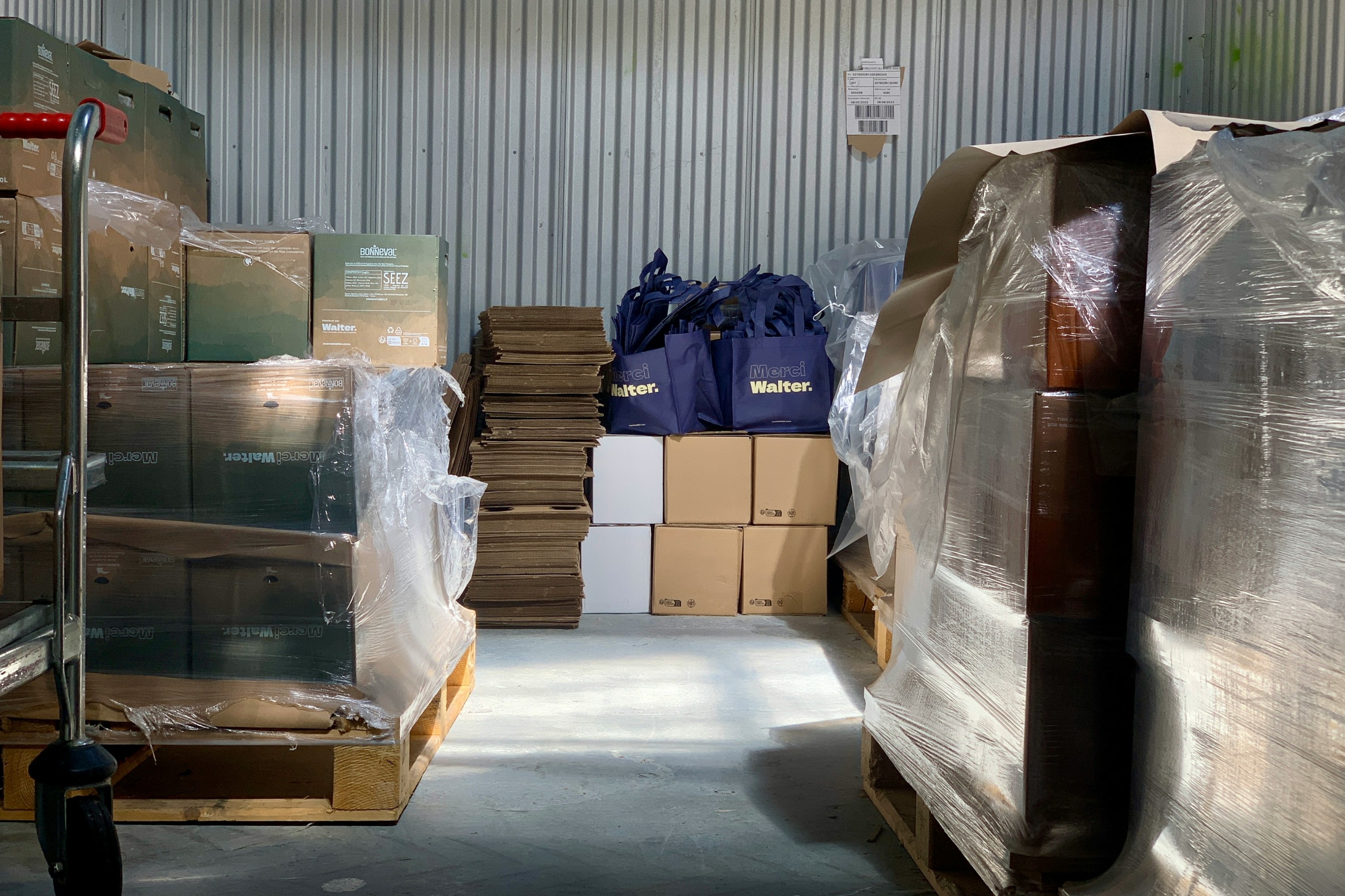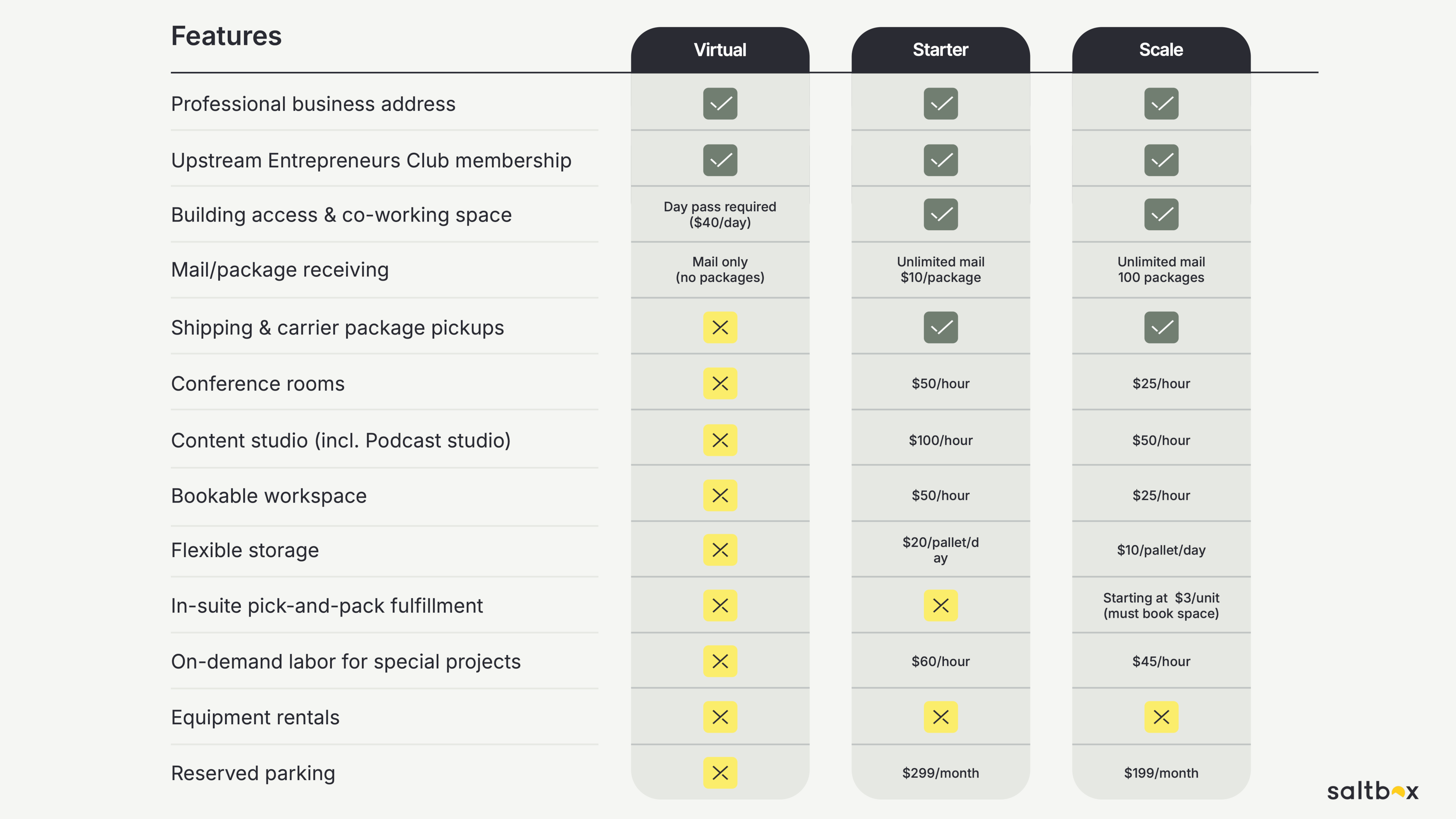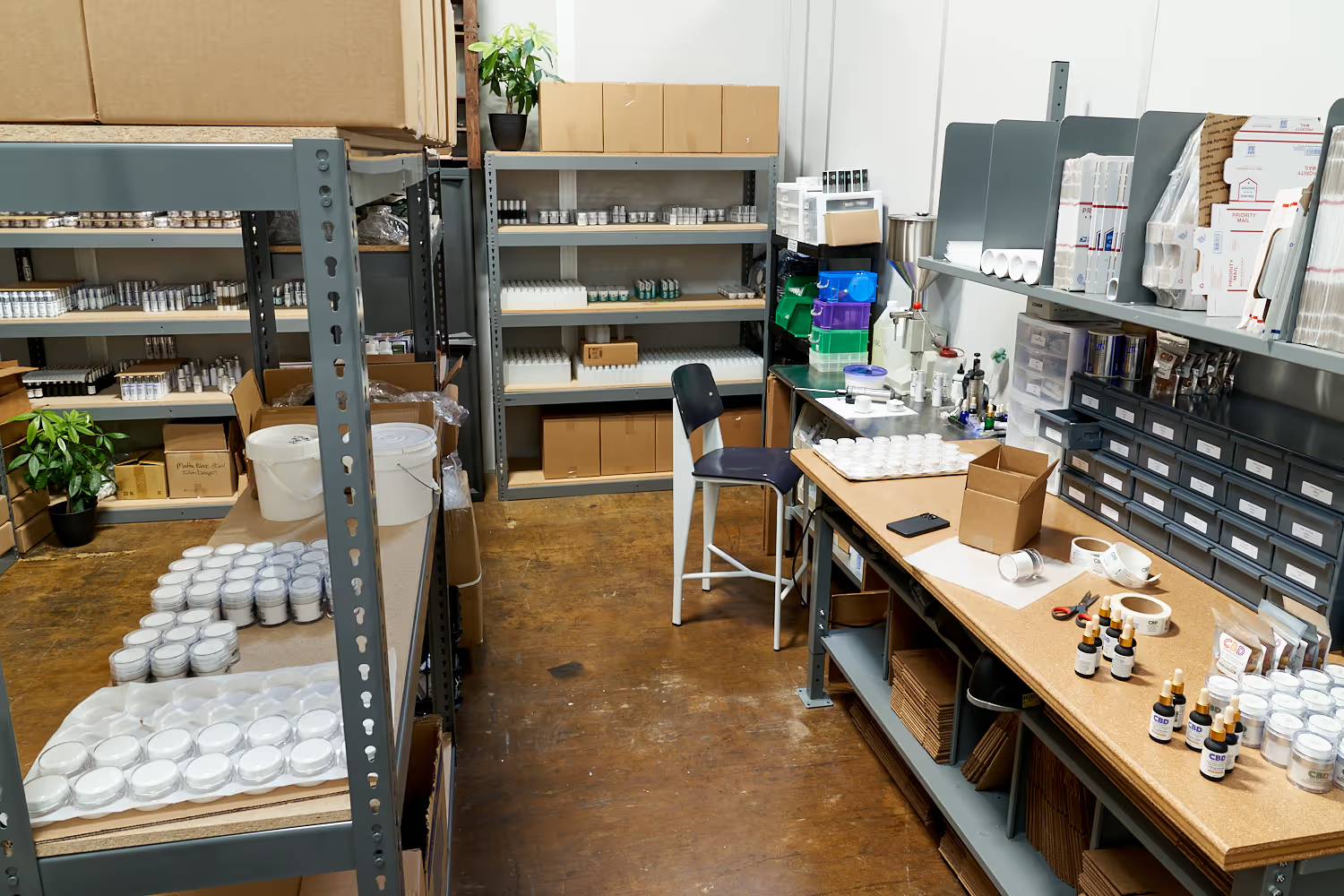Services that optimize small business logistics: Practical improvements without a warehouse
Let's be real—most small businesses don't wake up one day ready to sign a warehouse lease. And they shouldn't have to. Whether you're shipping from your kitchen counter or your second bedroom has morphed into a packaging zone, the fact is: logistics efficiency matters at every stage.
If your current setup feels like duct-taped chaos, you're not alone—and you're not out of options. With Saltbox Access Plans, businesses can take advantage of pro-level operations—like inventory receiving, discounted shipping, and returns processing—without leasing a warehouse
In this post, we unpack the smartest logistics improvements you can make today to streamline your operations, sharpen your customer experience, and reclaim your time. No lease? No problem.
Why logistics improvements matter before you're 'big'
Most small business owners think logistics only becomes important once they hit a certain growth stage. But your ability to fulfill quickly, respond to customer needs, and ship affordably isn't a “someday” conversation—it's a “right now” competitive advantage. Forward-thinking businesses that prioritize early logistics improvements are better positioned to achieve efficiency, cost savings, and improved customer service. To truly excel, it's essential to move beyond the status quo and embrace innovation in your logistics processes.
Here's what many small businesses get wrong: the first thing they should focus on is logistics improvements, not waiting for scale before strategy. But by building a strong logistics foundation and investing in the right infrastructure early on, you can avoid costly errors, unhappy customers, and burnout. Saltbox Access Plans help you make these strategic moves affordably and flexibly.
What is logistics, really?
Logistics is more than just moving boxes from point A to point B—it's the backbone of how businesses get goods into customers' hands, efficiently and reliably. At its core, logistics is the process of planning, implementing, and controlling the movement and storage of goods, services, and information throughout the supply chain. This means everything from sourcing raw materials, managing inventory, and coordinating transportation, to ensuring that every package arrives on time and in perfect condition.
For small businesses, understanding logistics is essential for reducing costs, improving efficiency, and boosting customer satisfaction. By implementing smart logistics practices early, you can streamline your operations, avoid costly mistakes, and set your business up for long-term success. Whether you're shipping a handful of orders or managing a growing product line, logistics plays a critical role in ensuring your goods reach your customers smoothly and efficiently.
The logistics journey: What happens behind the scenes
Ever wonder what really happens after a customer clicks “buy”? The logistics journey is a behind-the-scenes dance that brings goods from suppliers to your customer's doorstep. It starts with sourcing materials and ends when the final delivery is made. Along the way, your products might pass through multiple distribution centers, warehouses, and transportation hubs—all coordinated by a network of systems and software designed to keep things moving.
Businesses rely on tools like transportation management systems, warehouse management systems, and inventory software to track goods, manage stock, and ensure every item is accounted for. Effective communication with suppliers, manufacturers, and customers is key to making sure everything arrives on time and in good condition. By understanding each step of this journey, you can identify bottlenecks, use the right systems, and optimize your processes to improve efficiency and reduce costs. The more you know about what happens behind the scenes, the better equipped you'll be to ensure your logistics run like a well-oiled machine.
9 Tips to optimize your small business logistics operations
1. Professionalize your receiving process

Let's start at the top of the supply chain: getting your product into your hands.
If your current process involves missed FedEx deliveries or packages going to your home address, it's time for a glow-up. Saltbox Access Plans allow you to ship inventory directly to a Saltbox location, where team members:
- Accept and log your deliveries, sending notifications when they're ready for you to pick up
- Snap photos of incoming items for real-time visibility
- Store items safely in temperature-controlled spaces
Optimizing the layout of a distribution center can further improve the receiving process and overall operational performance.
No more waiting around for deliveries or wondering if your inventory was dropped off at the wrong unit. It's an easy win for logistics process improvement.
“Having someone accept shipments at our Saltbox warehouse allows us to focus more on growing the business instead of waiting around for packages and freight to arrive.” — Ken Robison, Hello Garage
2. Organize smarter, not larger

You don't need 5,000 square feet to act like a logistics pro—you just need the right system.
By strategically organizing your ecommerce workspace, you can store and manage more inventory efficiently, maximizing your available space and improving workflow. Optimizing the links between different storage and picking processes enhances overall efficiency and ensures smoother operations.
Here's how that translates to improved logistics efficiency:
- Faster pick-and-pack = faster fulfillment
- Less misplaced inventory = fewer errors
- Better organization = less chaos (and more confidence)
Maintaining a steady flow of goods through organized systems leads to fewer errors and faster fulfillment, supporting reliable and efficient logistics.
You're not just decluttering your shelves—you're decluttering your operations.
3. Use well-known inventory management hacks
Managing inventory doesn't have to be overwhelming—even for small teams. The secret? Smart systems and a few strategic hacks. One powerful approach is implementing a just-in-time (JIT) inventory system, which means you order and receive goods as you need them. This reduces the amount of money tied up in stock and helps cut down on waste.
Another game-changer is using inventory management software to track your items in real-time. With the right software, you can monitor stock levels, forecast demand, and quickly identify when it's time to reorder or adjust your strategy. Data analytics can also help you spot trends in customer demand, so you can fine-tune your inventory processes and avoid costly overstocking or stockouts.
By adopting these inventory management hacks, businesses can boost logistics efficiency, reduce unnecessary costs, and keep operations running smoothly—no matter how small the team.
4. Use tech to your advantage (yes, even early on)

Not ready for warehouse automation or a full-blown warehouse management system (WMS)? You can still get tech-forward. Leveraging technology can streamline logistics operations, making your supply chain more efficient and resilient.
Saltbox members using Access Plans get immediate access to Parsel, our shipping platform partner built specifically for small businesses. It's not your basic label printer—it's your fulfillment sidekick.
By integrating technology like Parsel into your logistics process, you can improve efficiency and simplify order management.
With Parsel, you can:
- Print discounted shipping labels (up to 30% off)
- Automatically sync Shopify orders
- Batch ship with ease
- Choose from national, regional, and local carriers
- Track everything from pickup to delivery
And if you're using Saltbox's dedicated workforce (eForce), our team can pick, pack, and label right from your on-site inventory, so you can outsource fulfillment without giving up control.
5. Offer returns without the logistical heartache
Returns are part of the ecommerce game. The question is: are they wrecking your workflow?
Here's the twist: even if you're not managing a full warehouse, Saltbox can help you process returns like a pro. We'll receive returned goods on your behalf, notify you when they arrive, and store them safely until you're ready to restock, inspect, or repackage. Efficient packaging practices can streamline the returns process and reduce costs, making operations smoother for your business. Our team is always available to assist with any questions or issues that arise during the returns process.
Need help building a returns policy? Download our worksheet, 5 tips to build a best-in-class returns policy
This means:
- No more P.O. Box pickups or mystery return piles
- No need to coordinate with multiple locations or carriers
- More customer trust and satisfaction
An efficient returns process isn't just logistics—it's customer experience. And it matters.
6. Gain shipping agility (and save money doing it)
We know shipping costs can crush your small business's margins. That's why Access Plans come with discounted rates on UPS, USPS, FedEx, and regional carriers via Parsel. But it's not just about cheaper labels—it's about smarter, faster, and more adaptable shipping. By consolidating partial shipments into full ones, Parsel helps you send packages more efficiently and reduce overall transportation costs. Tracking the number of shipments or deliveries also helps monitor and improve your shipping efficiency.
When considering shipping costs, remember to factor in the labor involved to sell your products—such as management, customer service, and fulfillment. Improvements in logistics can significantly reduce these selling-related expenses.
Angela Hawkins of Bamblu used Parsel to ship luxury bedding from Saltbox Atlanta to a customer in New Jersey—in just one business day. Because Parsel integrates directly with her ecommerce store, she was able to pick, pack, print, and drop off—all within 90 minutes, helping her meet tight deadlines and ensure timely delivery. Many businesses see cost reductions and improved shipping performance within just a few months of implementing these strategies.
“Shipping with Parsel has saved us both in money and headaches.” — Angela Hawkins, Founder, Bamblu
Shipping isn't just a backend function—it's part of your brand. Make it reflect the experience you're building.
7. Transportation and warehousing: What you need (and what you don't)
When it comes to transportation and warehousing, it's easy to think bigger is always better—but that's not always the case. The key is to understand what your business actually needs to move goods efficiently and cost-effectively. Transportation covers how your products get from one place to another, whether that's by road, rail, air, or sea. Warehousing is about storing your goods safely until they're ready to ship.
To determine the right setup, evaluate your business's needs:
- What types of goods are you moving?
- How often do you ship?
- How far do your products need to travel?
Sometimes, using a public or contract warehouse—or even outsourcing to a third-party logistics provider—can reduce costs and improve efficiency without the commitment of a private facility.
By taking the time to understand and evaluate your transportation and warehousing requirements, you can implement solutions that fit your business, reduce unnecessary expenses, and keep your logistics running smoothly.
8. Invest in your team: training for logistics excellence

Your logistics strategy is only as strong as the people behind it. Investing in your team's development isn't just a nice-to-have—it's a must for any business aiming for logistics excellence. Comprehensive training programs help your employees truly understand the ins and outs of logistics operations, from warehouse management to transportation optimization and supply chain best practices. Clearly defining roles within the logistics team is also essential, as it ensures everyone knows their responsibilities and contributes to operational efficiency.
When you prioritize training, you're not just boosting individual knowledge—you're fostering better communication and collaboration across your organization. Encourage employees to contribute ideas and take ownership of process improvements, which can lead to innovative solutions and a stronger team dynamic. This makes it easier to spot and address inefficiencies in your logistics processes before they become bigger issues. Well-trained teams can quickly adjust to new challenges, implement updated systems, and optimize processes for maximum efficiency and productivity.
Plus, ongoing training ensures your team stays up-to-date with the latest technologies and industry practices, so your business can continue to grow and compete effectively. The result? Smoother operations, higher customer satisfaction, and a logistics function that truly supports your business goals.
9. Scale on your terms, not on someone else's timeline
Here's the beauty of flexible logistics at Saltbox: you get to scale when you're ready, not when your lease says so.
Need more space? Add a suite later. Need help with fulfillment during the holidays? Loop in our dedicated team. Want to stay lean for a few more quarters? Stick with Access Plans.
Scaling logistics operations may require investment in new solutions or infrastructure, but with flexible options like Access Plans, you can optimize without committing to high upfront costs. Flexible logistics plans also enhance your business's capabilities to adapt quickly to changing demands and market conditions. By partnering with technology or sustainability experts, you can further strengthen your logistics operations, ensuring resilience and compliance as the industry evolves. Flexible logistics plans help businesses optimize their supply chains, supporting efficient growth and adaptability
Saltbox was built for businesses that grow in seasons and spurts—not just spreadsheets. Your Access Plan can evolve as your needs do. That's the real logistics improvement: building operations that match your actual growth.
Overcoming common logistics challenges (before they trip you up)
Every business faces logistics challenges, but the smartest ones tackle them head-on before they become roadblocks. Meeting tight deadlines, reducing costs, and keeping operations efficient are all common hurdles. The good news? With the right approach, you can overcome these challenges and keep your logistics on track.
Start by establishing key performance indicators (KPIs) to measure your logistics efficiency—think delivery times, order accuracy, and cost per shipment. Implementing technology and automation can help streamline processes and reduce manual errors. Foster open communication and collaboration between departments to ensure everyone is aligned and issues are addressed quickly.
By proactively identifying challenges and implementing efficient logistics practices, businesses can reduce inefficiencies, meet customer expectations, and stay ahead of the competition. Remember, efficient logistics isn't just about moving goods—it's about building a system that supports your business's growth and success.
TL;DR — You don't need a warehouse to achieve logistics efficiency
Let's break the myth right now: efficient logistics isn't reserved for businesses with five-figure square footage. If you're a small business with big goals, Saltbox Access Plans are your logistics cheat code. You get the professionalism of a logistics team without the overhead. You get to grow your way, with tools designed for agility, not excess.
Here are some logistics services you can unlock* with Access Plans:
✅ Professional business address
✅ Digital community to make building your empire feel less alone
✅ Co-working space
✅ Shipping and carrier package pickups
✅ On-demand labor for special projects
✅ Pick-and-pack fulfillment support
✅ Flexible storage
✅ No long-term lease required
*Price and availability vary for different Access Plan membership tiers. Compare plan types below to find the right fit.

Still aren't sure if a warehouse is right for you? Check out our blog, "Do you need a warehouse to run an ecommerce business?"
Frequently asked questions (FAQs)
What are services that optimize small business logistics?
These services include various strategies, tools, and solutions designed to streamline logistics operations for small businesses. They help improve inventory management, order fulfillment, transportation management, and overall supply chain processes to reduce costs and enhance customer satisfaction.
How can logistics software benefit small businesses?
Logistics software automates and optimizes key logistics tasks such as shipment tracking, route optimization, and inventory management systems. This leads to more efficient operations, cost-effective delivery services, and improved customer experience.
Do small businesses need a warehouse to improve logistics?
No, small businesses can optimize their logistics without leasing a warehouse by using flexible solutions such as third-party logistics providers, cloud-based management systems, and access plans that offer inventory receiving and shipping services.
What is the role of inventory management systems in logistics?
Inventory management systems help small businesses maintain accurate stock levels, forecast demand, and reduce waste. They are critical for efficient supply chain operations and ensuring timely delivery to customers.
How can small businesses handle returns efficiently?
By implementing streamlined returns processing through third-party services or dedicated logistics teams, small businesses can reduce logistical challenges, enhance customer trust, and maintain a smooth supply chain.
Why is route optimization important for small business logistics?
Route optimization reduces transportation costs and fuel consumption by planning the most efficient delivery routes. This improves delivery times and overall cost efficiency, benefiting both the business and its customers.
How can small businesses overcome budget constraints in logistics?
Small businesses can leverage cost-effective logistics solutions such as on-demand delivery services, cloud-based logistics management software, and partnerships with third-party logistics providers to optimize operations without large upfront investments.
What key performance indicators (KPIs) should small businesses track in logistics?
Important KPIs include delivery times, order accuracy, cost per shipment, and customer satisfaction metrics. Monitoring these helps identify bottlenecks and improve logistics processes continuously.
For Her
For Him
For Pets
For Anyone

Related posts
Learn from businesses improving their operational efficiency. Explore how Saltbox’s expert support and flexible spaces drive their growth.


Black Friday ecommerce strategy: Complete 2025 guide to maximize holiday sales
Discover a comprehensive Black Friday ecommerce strategy for 2025 to maximize your holiday sales. Learn expert tips on technical optimization, targeted marketing, inventory planning, and customer retention to boost your online store’s performance during the busiest shopping season.


The ultimate small business holiday gift guide 2025
Every item in this guide comes from a Saltbox member. Thoughtfully made, ready to ship, and powered by small businesses.


Holiday shipping deadlines 2025: Complete guide for on-time delivery
This comprehensive guide covers every major carrier’s 2025 holiday shipping deadlines, from standard ground services to last-minute express options.







